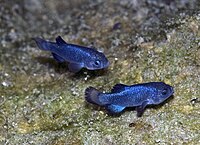
Photo from wikipedia
We have maintained pupfish derived from a refuge population of the critically endangered Devils Hole pupfish (Cyprinodon diabolis) and the closely related and endangered Ash Meadows pupfish (C. nevadensis mionectes)… Click to show full abstract
We have maintained pupfish derived from a refuge population of the critically endangered Devils Hole pupfish (Cyprinodon diabolis) and the closely related and endangered Ash Meadows pupfish (C. nevadensis mionectes) in our laboratory for 9 years at the ecologically relevant temperatures of 28 and 33 °C. We asked if insights gained by our captive husbandry could inform on what pressures may be impacting the conservation of these fishes in the wild. Breeding is affected by temperature such that few eggs are deposited by fishes maintained at 33 °C. Fish acclimated to either 28 or 33 °C prefer 28 °C suggesting native habitats such as Devils Hole are not optimal for the fish. In addition to temperature, we found that providing cover in the form of aquarium plants and carpet squares increased egg deposition and larval survival presumably due to reduced oophagy and cannibalism of newly hatched larvae. The decline of the native population of C. diabolis coincided with a change in the algal community of Devils Hole from mats of green algae to sheet forming cyanobacteria. Our experiments suggest this lack of cover resulted in oophagy and cannibalism that reduced the reproductive capacity of Devils Hole pupfish. We suggest efforts at restoring cover in Devils Hole will have the greatest impact on enhancing survivorship of this species especially in light of the reduced breeding opportunities that will likely result from continuing global climate change.
Journal Title: Environmental Biology of Fishes
Year Published: 2019
Link to full text (if available)
Share on Social Media: Sign Up to like & get
recommendations!